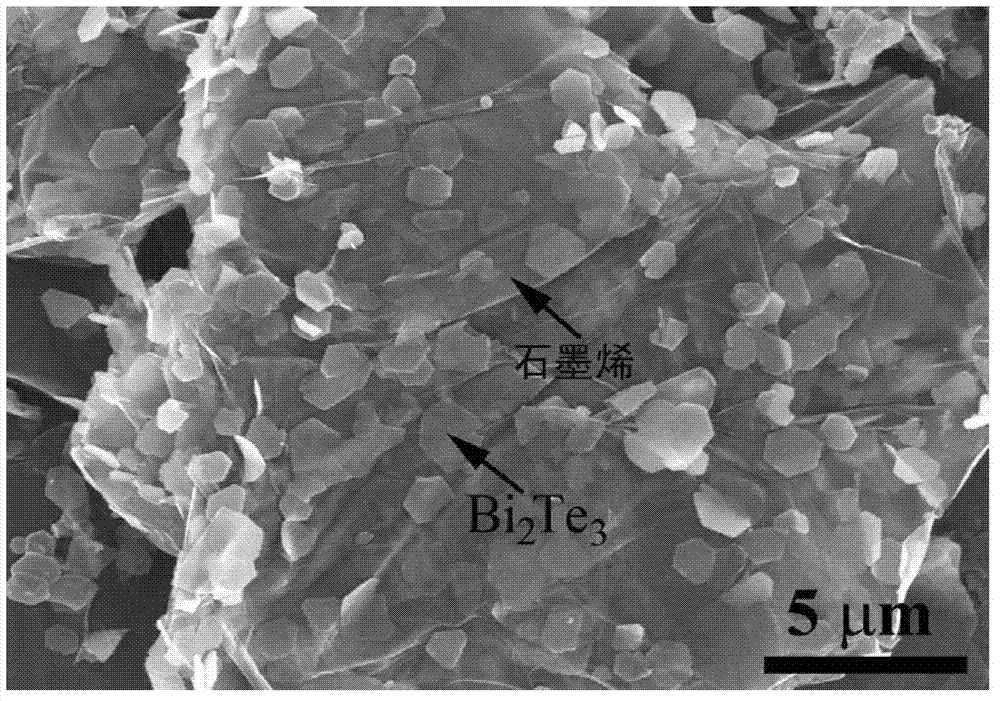Bi2Te3 thin-piece/graphene composite material, preparation method and applications thereof
A composite material and graphene technology, applied in the direction of graphene, binary selenium/tellurium compounds, thermoelectric device junction lead-out materials, etc., can solve the problems of weakening phonon scattering mechanism, easy agglomeration of fine grains, sintering, etc. Achieve the effect of low cost, improved thermoelectric performance, and uniform distribution
- Summary
- Abstract
- Description
- Claims
- Application Information
AI Technical Summary
Problems solved by technology
Method used
Image
Examples
Embodiment 1
[0033] 1) The analytically pure BiCl 3 and Te powder, according to the ratio of Bi:Te atomic ratio of 2:3 and mixed in absolute ethanol to obtain Bi 2 Te 3 The meter concentration is the mixed solution of 0.015mol / L, and the mixed solution volume is 80 milliliters.
[0034] 2) Add 48 mg of GO to the mixture in step 1) and fully ultrasonically disperse it, then place it in a high-pressure reactor with a capacity of 100 ml (filling degree 80%, volume percentage), and then add 1.2 g of reducing agent NaBH to the solution 4 , and then add 6M NaOH aqueous solution to adjust the pH value to 10, and then seal it immediately.
[0035] 3) Heating the reactor to 180°C and reacting for 24 hours.
[0036] 4) Naturally cool to room temperature after the reaction, collect the powdery reaction product at the bottom of the kettle, wash it with deionized water and absolute ethanol alternately and repeatedly for several times, then vacuum dry the powder at 110°C for 12 hours to obtain a comp...
Embodiment 2
[0039] 1) Analytical pure Bi(NO 3 ) 3 ·5H 2 O and Na 2 TeO 3 , according to the ratio of Bi:Te atomic ratio of 2:3 and mixed in deionized water to obtain Bi 2 Te 3 The meter concentration is the mixed solution of 0.03mol / L, and the mixed solution volume is 80 milliliters.
[0040] 2) Add 58 mg of GO to the mixture in step 1) and fully ultrasonically disperse it, then place it in a high-pressure reactor with a capacity of 100 ml (filling degree 80%, volume percentage), and add 3.2 g of reducing agent KBH to the solution 4 , and then add 6M KOH aqueous solution to adjust the pH value to 11, and then seal it immediately.
[0041] 3) Heating the reactor to 160°C and reacting for 48 hours.
[0042] 4) Naturally cool to room temperature after the reaction, collect the powdery reaction product at the bottom of the kettle, wash it with deionized water and absolute ethanol alternately and repeatedly for several times, then vacuum dry the powder at 110°C for 12 hours to obtain a ...
Embodiment 3
[0045] 1) will analyze pure BiF 3 and K 2 TeO 3 Bi 2 Te 3 The meter concentration is the mixed solution of 0.09mol / L, and the mixed solution volume is 80 milliliters.
[0046] 2) Add 57 mg of GO to the mixture in step 1) and fully ultrasonically disperse it, then place it in a high-pressure reactor with a capacity of 100 ml (filling degree 80%, volume percentage), and add 6.9 g of reducing agent NaBH to the solution 4 , then add 6M NaOH aqueous solution to adjust the pH value to 11 and seal immediately.
[0047] 3) Heating the reactor to 200°C and reacting for 36 hours.
[0048] 4) Naturally cool to room temperature after the reaction, collect the powdery reaction product at the bottom of the kettle, wash it with deionized water and absolute ethanol alternately and repeatedly for several times, then vacuum dry the powder at 110°C for 12 hours to obtain a composite material powder 5.8 grams, the weight percentage of graphene in the composite material is 0.4%.
[0049] Th...
PUM
| Property | Measurement | Unit |
|---|---|---|
| size | aaaaa | aaaaa |
| diameter | aaaaa | aaaaa |
Abstract
Description
Claims
Application Information
 Login to View More
Login to View More - R&D
- Intellectual Property
- Life Sciences
- Materials
- Tech Scout
- Unparalleled Data Quality
- Higher Quality Content
- 60% Fewer Hallucinations
Browse by: Latest US Patents, China's latest patents, Technical Efficacy Thesaurus, Application Domain, Technology Topic, Popular Technical Reports.
© 2025 PatSnap. All rights reserved.Legal|Privacy policy|Modern Slavery Act Transparency Statement|Sitemap|About US| Contact US: help@patsnap.com


